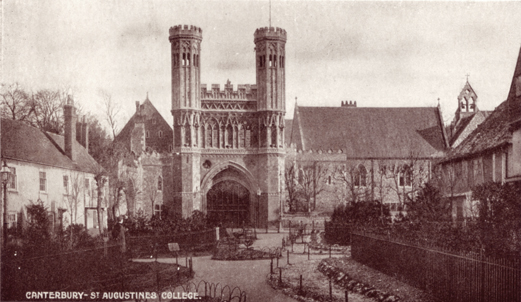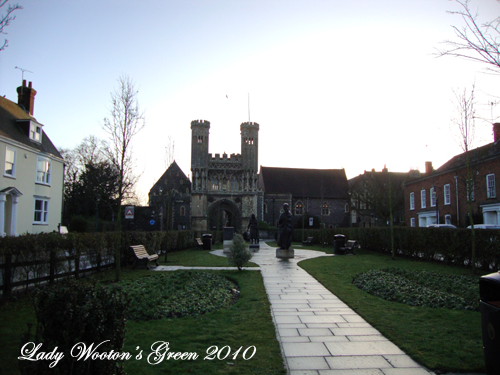
![]()
~ ST. AUGUSTINE'S GATE ~
FYNDON'S GATE, CANTERBURY
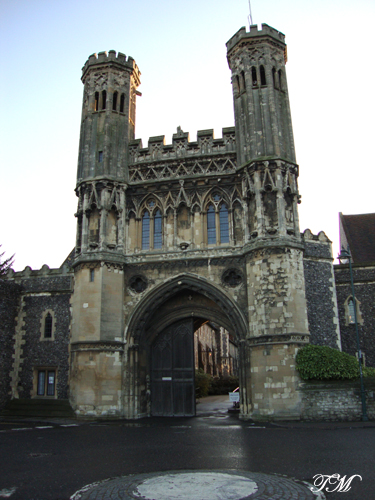
Was erected in the time of Abbot Fyndon, between the years 1297 and 1309, most probably at the expense of the Convent
"The grand gate of the Monastery faces a small square known since the reign of Charles I. as Lady Wootton's Green. The gate is flanked by two octagonal towers which rise like minarets above the main building. A pointed arch springs from tower to tower, and within it is a second arch which frames in the massive door of panelled oak. The traceried windows of the gate chamber are bays in an arcade of singular beauty. The canopied niches span the entire building, encompasing the towers on either side. Above is a band of trefoiled triangles, and over that a decorated battlement; while over all, the two turrets panelled, pierced and battlemented complete a facade which resembles an exquisite piece of lacework translated to stone. This noble gateway is harmonious in all its details. It is fortunate indeed that so perfect a work was spared by the spoilers of the once magnificent Abbey.
It had, however, some years previous to Mr. Hope purchasing it, been partially repaired through the efforts of a few public spirited individuals and some of the leading members of the Canterbury Literary Institution. Pull it down and sell the materials, was the cry. Happily however for the honour of the City, this act of spoliation was averted. The turrets were again restored in 1890-91.
The gateway was erected by Abbot Fyndon, who, in the year 1300 obtained a charter for the enlargement of the great court of the Monastery. During 1309, the last year of his Abbacy, he obtained from the King, Edward II., leave to embattle the gate of his Abbey.
We now enter the gate with its finely vaulted archway, above which is the gate-chamber, formerly used as the state bed-chamber of the Monastery. It contains five windows, two westward, one eastward and two northward, the fireplace being on the southside. It has a curiously painted ceiling, which, after the conversion into a brewery, was miserably defaced by the steam."
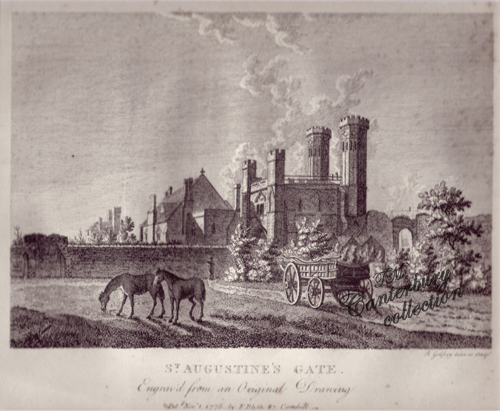
The Gate of St. Augustine's Abbey, Canterbury c. 1775 showing the Cemetery gate off in the distance
*In 1703 a storm severely damaged many of the buildings

The first of these two gateways, which is the entrance to the college, was built by Abbot Fyndon, 1300; the second by Ickman, 1399. A royal palace took the place of the monastery after the Dissolution, which was given by Queen Mary to Cardinal Pole, and, in later years, to Lord Wotton, after which it was known as Lady Wotton's palace. But it gradually fell into lower depths, a cockpit, a fives-court, a bowling alley, and lastly a brewery, occupying the site and ruins, until, 1844, it was bought by Mr. Beresford Hope, and rebuilt as a missionary college, from designs by Butterfield for a warden, six fellows, and about fifty students. The ancient foundation is, therefore, refulfilling its early intention. The buildings now consist chiefly of the library (which has a fine Oriental collection) on the site of the refectory, the College Hall (the original Guest Hall, with its open roof), the chapel and the cloisters, with the students' rooms above. On the south side of the quadrangle are the scanty ruins of the old church. The open ground in front of the principal gateway is still called Lady Wotton's Green. Handbook to the County of Kent
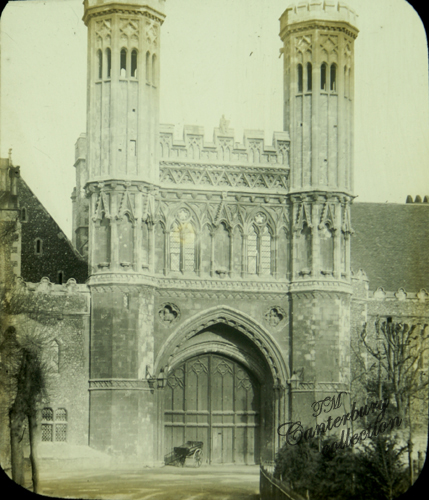
St. Augustine's Gate from an old Magic Slide in my collection
The ancient foundation is, therefore, refulfilling its early intention. The buildings now consist chiefly of the library (which has a fine Oriental collection) on the site of the refectory, the College Hall (the original Guest Hall, with its open roof), the chapel and the cloisters, with the students' rooms above. On the south side of the quadrangle are the scanty ruins of the old church. The open ground in front of the principal gateway is still called Lady Wotton's Green. Handbook to the County of Kent


The Gate of St. Augustine's Abbey, Canterbury c. 1811
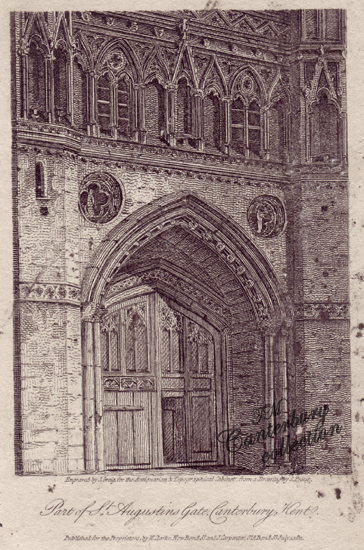 ___
___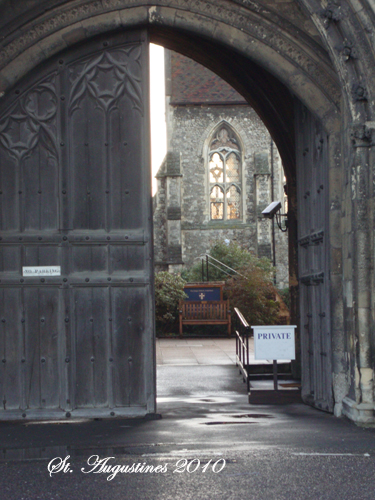
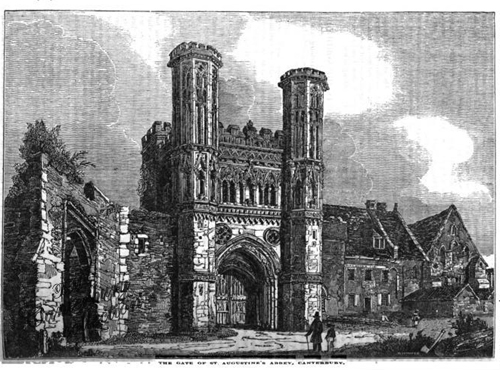
The Gate of St. Augustine's Abbey, Canterbury c. 1833
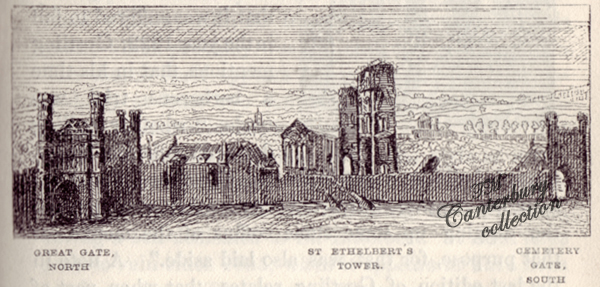
The west front of this Abbey extended, in length, 250 feet, and had a gate at each extremity: these gates are yet standing, together with the buildings adjoining the principal one, St. Augustine's Gate, as it is still called. This is a very elegant structure, though the interior is much dilapidated, it having been converted into a brewery. The front consists of a centre, united by octagonal towers, which rise above the roof in lofty turrets, finished by a rich cornice and battlement, and pierced by small and highly-ornamented windows: under the cornices are various heads of much expression and character; others of similar execution adorn the angles within the turrets; in the spandrils, above the entrance arch, within quatrefoil recesses, surrounded by circles, are statues, now greatly broken and defaced; indeed the whole of this entrance exhibits a degree of taste rarely surpassed by the ornamental sculpture of any age. The large room over the entrance has been converted into the city cockpit; and so singular are the changes the different parts of this foundation have undergone, that we find a fives-court, a bowling-green, a skittle-ground, an hospital, and a goal, within the circuit of the walls.
Ancient Reliques by James Andrew Storer, William Sankey, Frederic Grosvenor Goodridge 1808
 __
__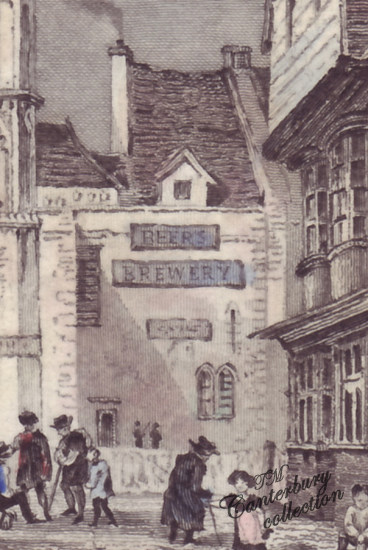
A view of St. Augustine's Gate (the entrance to the College), and the BEER brewhouse that was located beside it
"The principal entrance is, however yet standing, and in a good state of preservation, and is used as a brew-house, by Messrs. Bennett & Beer." 1824
1828-29 - BENNET & BEER - BREWERS, St. Augustine's
1832 - William Beer, St. Augustines Brewery, BREWER
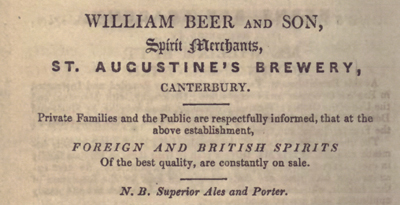
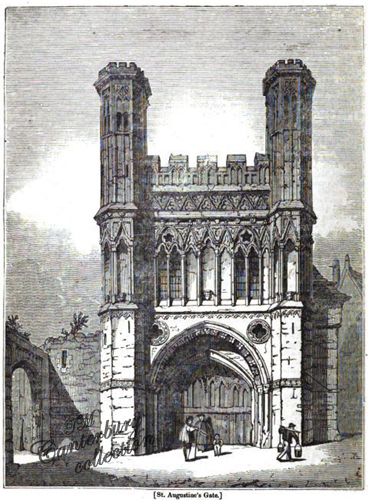
The Gate of St. Augustine's Abbey, Canterbury - Penny Magazine
"At the time I am writing of, St. Augustine's monastery at Canterbury was desecrated to the purposes of a brewery such are the base uses to which some of hte noblest buildings which man can erect are subject to, and the gardens adjoining, once the resting-place of the nuns and monks of the holy order instituted by their illustrious founder, were used as a bowling-green and tea-drinking place for the plebeians of Canterbury. A part of the original building was used as a fives-court, or racket-ground, and I have seen in my early days some good matches played there between the citizens of Canterbury and some crack players from London.
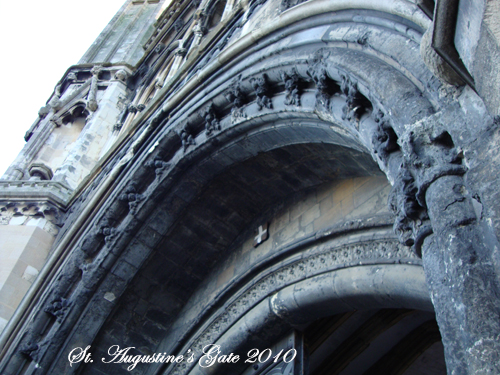
I am happy to be able to record, for the information of such of my readers as may not be aware of the fact, that this grand old monastery of ancient story, and its beautiful ruins have been rescued from these base purposes by the munificent liberality of Mr. Beresford Hope, a gentleman well known and very highly respected by all lovers of art. That which was used as a brewery has long since given place to a missionary college, under the able presidency of the Rev. Henry Bailey, B.D., the successor of the lamented Bishop Coleridge the first warden of the College; and the chamber over the fine old gateway that was once devoted to cock-fighting-this is a veritable fact - is, I believe, restored as much as possible to its original appearance, and is now used as a council-chamber by the heads of the college.
The tea-gardens connected with the public-house adjoining the brewery, and part of the sacred building of St. Augustine, on Lady Wootton's Green, presented, at the time I am referring to, a kind of Cremorne on a small scale. Fireworks, balloons, and the Blondin of those days, attracted crowds of Canterbury lads and lasses, and the old people as well - for it is most observable that at all our places of amusement devoted almost exclusively to young persons, there will be found not a few venerable-looking men and women, who appear to be quite as much delighted with what is going on as the young people.
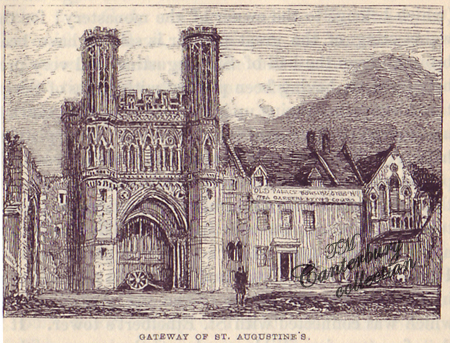
Felix Summerly 1843, the building beside the gate has a sign noting Old Palace Bowling Green, Tea Garden and Five's Court
St. Augustine's brewery! (for so it was designated; what would the grand old saint have said to such degredation?) - was at the time rented by the father of a schoolfellow of mine of the name of Beer, a somewhat singular coincidence, and will afford a hint to Mr. Lower, in a new edition of his interesting work on "Surnames."
I can say with very much peasure that having enjoyed the entree to this establishment at all times, I can record the many happy hours sepnt in the fine old building, often climbing its lofty towers, which are even now in a fine state of preservation, to look out upon the splendid view to be obtained from the summit; and many a draught have I had of the good home-brewed, wholesome beverage manufactured under its roof.
The brewery has been removed, and the building reclaimed from its odour of malt and hops to some of its primal sanctities. The brewer, who heartily welcomed me within its sacred walls, is dead; his son my schoolfellow, carries on the business at a short distance fromt he original spot: he hardly recognized me a few years since, when I called to renew the acquaintance of our early days, and to remind me of some of my juvenile reminiscences."
Passages from the auto-biography of a "man of Kent" Robert Cowtan 1866
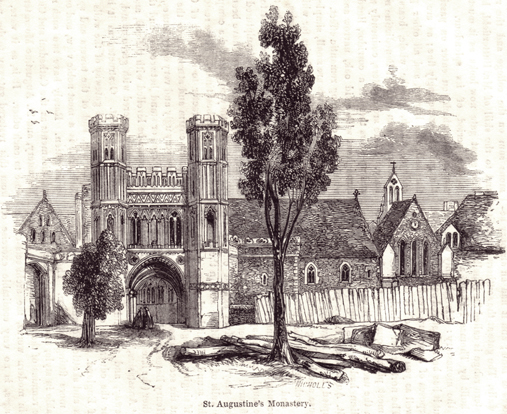
OLD PALACE GARDENS, CANTERBURY
Mr. Stanmore
(Late of Canterbury Theatre).
Begs most respectfully to inform the inhabitants of Canterbury and its Vicinity that the above Gardens will open under his direction.
On Tuesday, July 31st, 1836,
and will continue open every
TUESDSAY AND THURSDAY EVENING,
during the season upon the principal of
THE ROYAL GARDENS, VAUXHALL,
And trusts these entertainments will give that satisfaction and meet with the support it will be his study to deserve. The beauty of the Gardens are (sic) known to all, and their appearance will be highly imposing when
ILLUMINATED
with nearly
TWO THOUSAND VARIEGATED LAMPS.
The Concert
will take place in the spacious Orchestra erected in the
Gardens, for which
Miss MEARS,
of the Theatre Royal, Covent Garden, and Drury Lane, and
Mr. WARREN,
Late of the Royal Gardens, Vauxhall, and several other
professional persons are engaged.
etc. etc.....
"Two years ago the site was occupied by a brewery, and a dependent public house and bowling green. The great room over the archway of the principal gate was a cock-pit, and although the sport has decayed, it was not so many years since the time when mains used to be fought in that apartment. One ancient room, disfigured by modern windows, was a taproom; they played at fives against the venerable walls of the edifice, and in the summer months the sound of skittle playing, quiots, and singing were never silent."
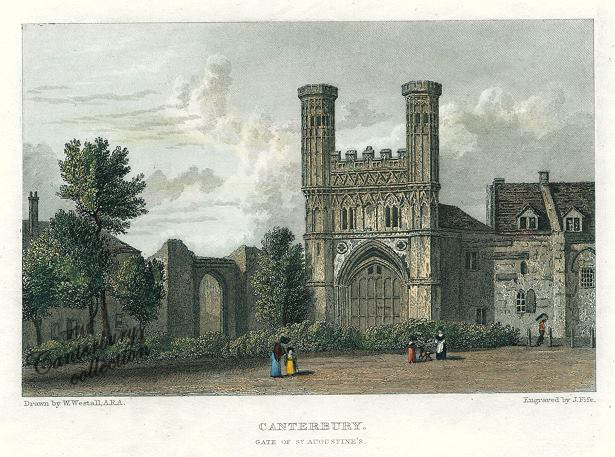
"Canterbury, Gate of St. Augustine's" engraved by J. Fife after a picture by W. Westall, published 1830. 'Image courtesy of antiqueprints.com'
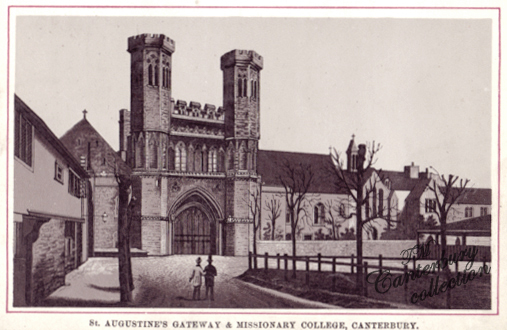
St. Augustine's Gateway & Missionary College, Canterbury c. 1890's
Of this extensive Abbey, the wall of which enclosed a space of about sixteen acres of ground, and the length of whose west front alone was 250 feet, little now remains. At each extremity of the west front was a gate. These are still standing, and, as may be judged from the specimen of one of them given in this number, are, considering their age, in good preservation. St. Augustine's Gate, formerly the grand entrance, was erected about the year 1300. The centre is rich in ornamental work, consisting of small lancet-shaped arches, supported by light columns. Two lofty and graceful towers rise above the roof. The old wooden doors, under a finely arched recess, are carved in the ancient style; and the vaulting within the entrance is light and beautiful. Over this gate, is a good-sized room, which possesses marks of antiquity, and is reported to be that in which Queen Elizabeth was entertained. It was afterwards used by some of the ruder inhabitants of Canterbury for the cruel and disgraceful sport of cock-fighting; but it is now unemployed. Proceeding from the door of this room, some narrow and time-eaten stone steps lead up to the top of the northern turret, within which are to be seen numerous grotesque carvings of the human face, distorted by the fertile ingenuity of the old sculptors. The opposite turret has a similar flight of stairs. The heads, and other embellishments at the intersections of the arches in the lower parts of the building, are much darkened and disfigured, partly in consequence of the smoke and steam of a brewerey, the business of which is carried on immediately within the gate, by a person of the appropriate name of Beer. No wanton injury is, however, done to any part of the structure; on the contrary, we are informed, that it is, as far as possible, kept up, and that a few years since, a sum was collected towards preventing its going entirely to decay.
Should any of our readers, when at Canterbury, be induced, by this description of the place, to enter the old gate of St. Augustine's Monastery, we would recommend them to view the ruined chapel; to mark the vast circuit of the Abbey-walls, which to this day show its extent; and (as a curious instance of ancient masonry,) to notice a remarkable piece of flint-work in the north-east corner within the gate, in which the flints are squared, and fitted smoothly together like so many bricks. The other gate at the southern end of the west front, is called the Cemetary gate, from its having led to the ancient burial ground. It is very like that of St. Augustine's, but less venerable in appearance, having been altered and adapted to the purposes of a modern dwelling-house.
The Saturday Magazine 1833

 __
__
"Views of St. Augustine's Gateway" from old postcards
